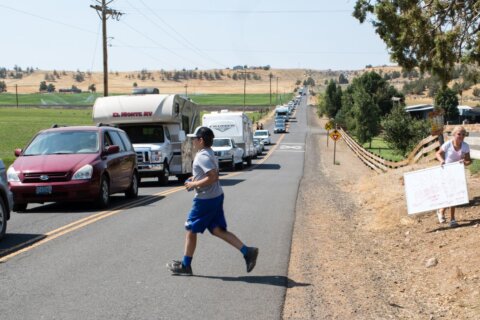FAIRFAX, Va. — At least part of Interstate 66 is likely to be widened inside the Capitol Beltway despite opposition from Arlington residents and despite planned changes to HOV restrictions along the narrow corridor.
After a briefing for elected leaders last week, Virginia Transportation Sec. Aubrey Layne said that “eventually there is going to be expansion needed.”
His office is negotiating what traffic issues would trigger the construction of a third eastbound lane along I-66 between the Dulles Connector Road and Ballston. Some residents and elected leaders who live in western Fairfax, Loudoun and Prince William counties would prefer to see that expansion much sooner than current plans call for.
“It’s both transportation and political realities that are driving this plan. We agree we should exhaust every other opportunity that we can to move more people through before we enter into capacity changes,” Layne says.
Virginia Transportation Deputy Sec. Nick Donohue says the third lane would only be added after the other changes already planned for the corridor are in place.
“What we’re going to do is implement the conversion to dynamic tolling (in 2017), allow the increase in occupancy requirements to take place (by 2020), as well as run these additional buses and other multimodal improvements (expected around 2021). And after a period of several years, we’re going to go back in and evaluate the facility,” he says.
In 2017, vehicles with two people in the car will still travel for free. Solo drivers will also be allowed in the lanes during the rush hour but will pay a toll that varies based on the number of vehicles in the lanes.
By 2020, only vehicles with three or more people inside will ride free.
The HOV and toll restrictions will take effect for both westbound and eastbound I-66 during both the morning and afternoon commutes in 2017.
“If congestion still exists, then a portion of the toll revenues will be sequestered and used to widen 66 between the Dulles Connector Road and Ballston to provide three through lanes through that corridor. And if they don’t, we’re simply not going to spend tens of millions of dollars, potentially $100 million to widen a roadway where congestion does not exist,” Donohue says.
Ongoing construction on the westbound side of I-66 will provide four through lanes stretching from near Washington Boulevard to the Dulles Connector Road.
“This is some of the most highly negotiated and congested stretch of interstate in the entire country. We have been debating what it should look like and whether it should be built before it was built, and ever since then there have been endless debates on both sides of the spectrum with regard to what should happen to this corridor,” Donohue says.
While some commuters have asked for 66 to be expanded all the way to the D.C. line, Layne says that is not feasible, both because of the cost and because of the location where the interstate ends in the District.
“To expand inside the Beltway is extremely expensive. Why wouldn’t we look at all the other alternatives first? But there’s also a recognition that if the growth numbers are right, and those metrics are hit, we’re going to need additional capacity, not only for the commuters coming through, but for those that live in Arlington to get around,” Layne says.
A separate project would add new HOV/toll lanes on I-66 in both directions from the Beltway to Gainesville by 2021. The project would lead to three regular lanes and two express lanes in each direction.
Virginia leaders have promised to add new peak-direction commuter routes and four new park-and-ride lots as part of the project. Public meetings on the proposed preferred alternative for the project are scheduled next month.







